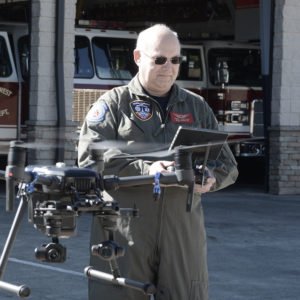
The following is one of a biweekly serieson public safety drone issues by Steve Rhode, Chief Pilot with the Wake Forest Fire Department and the North Carolina Public Safety Drone Academy, and founder of Public Safety Flight, a website dedicated to information about the use of unmanned aircraft systems (UAS), UAVs, aircraft, and drones in public safety. (Not to be contrued as legal advice: please see details at the FAA government site. Opinions are the author’s.)
Why Even Fly by FAA Rules?
DRONELIFE gives me a column and a platform to share information with public safety UAS pilots, and I’m grateful for the opportunity. But here is something you would never expect to hear from me. Do the FAA rules even matter?
The FAA has done a complicated job of pushing drones, regulating drone flight, and providing little enforcement for drone pilots that break the rules. Yet, if you look at the map, DJI publishes and brags about drones; nearly every listing would be a perfect opportunity for the department and pilot to be investigated for non-compliant flights.
Manufacturers push marketing messages about BVLOS flights or selling drones that can do all sorts of automated or complicated flights. The marketing departments do this without consequence.
Associations and conferences promote all sorts of magic uses of drones in public safety. Pilots all over fly to the standards they hear or assume.
The media celebrates heroic drone flights that result in some positive outcomes.
But what is the one thing much of that has in common? None of the flight is within the Federal Aviation Regulations.
What is happening right now without FAA enforcement is an entire generation of pilots is being trained that the rules don’t matter.
I’ve been a manned airplane pilot since 1988, and in all my years flying, it was always beaten into me; the rules did matter and had consequences.
Can you sense my frustration?
The people who are getting shafted here are the public safety drone pilots who will believe what they see in marketing, associations, and conferences.
The Federal Aviation Regulations don’t seem to matter until the day they all do, and the FAA wakes up to enforce the regulations.
It is inevitable. More drones in public safety will result in more accidents and injuries from non-compliant flights. Those events will result in more lawsuits, and governments and pilots will lose when the flight is compared to the regulations on the books.
Once Plaintiff attorneys realize it won’t take more than a few minutes to demonstrably prove the department and pilot engaged in a non-compliant flight, the lawsuits will flow.
For those that take the time actually to read the CFR Part 107 regulations they will discover what they assume about drone flight does not match the rules.
I recently did a podcast with Fred Carlson from FDNY, and it was refreshing to hear him talk about their approach to flight operations. First, they make an effort to follow the flight rules. Second, it reduces the pilots and department liability by not doing stupid things.
Some core rules of aviation are:
- Aeronautical Decision Making – Making intelligent and correct decisions on any flight and in any phase of flight will help you and your department avoid liability.
- Risk Management – Knowing what the regulations are can help you make educated decisions about the level of risk you are willing to expose yourself to in any flight, so you know what is wise, calculated, or just stupid.
- Ignorance is No Defense – You don’t want to be like the pilot in Seattle that was sentenced to 30 days in jail for a flight that created a “substantial risk of death or serious bodily injury to another person.” Saying you didn’t know what the regulations were is not a winning strategy.
- As a Pilot, You Will Always be Guilty Before Being Proven Innocent – When your drone falls from the sky, has a flyaway, or injuries someone on the ground, you will have to demonstrate your decisions and actions did not lead to the incident. Every public safety pilot, COA or Part 107, is subject to CFR 91.3 “The pilot in command of an aircraft is directly responsible for, and is the final authority as to, the operation of that aircraft.”
Until the day comes, the FAA, NTSB, and Plaintiff attorneys wake up and start taking action against pilots and departments; there is no reason to follow the rules. But what day will that be, and will you be ready?